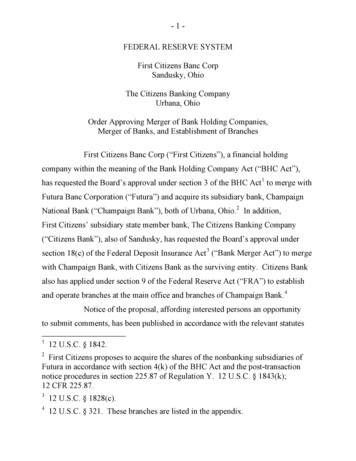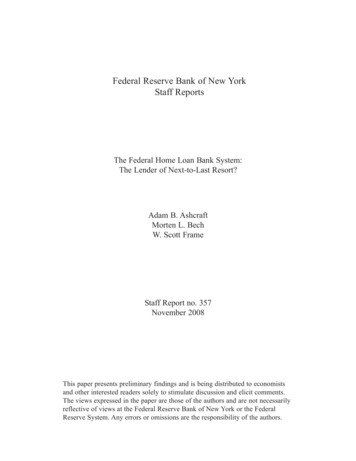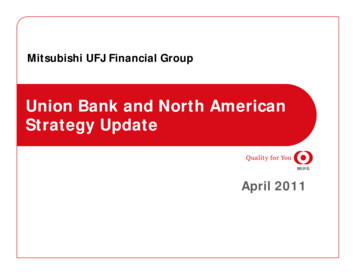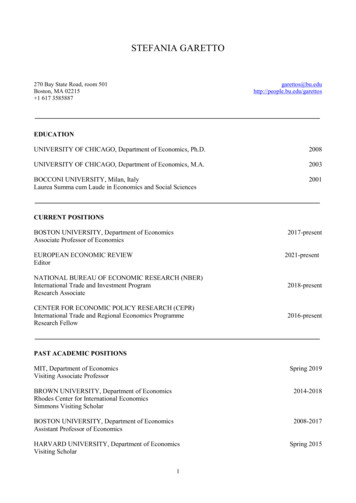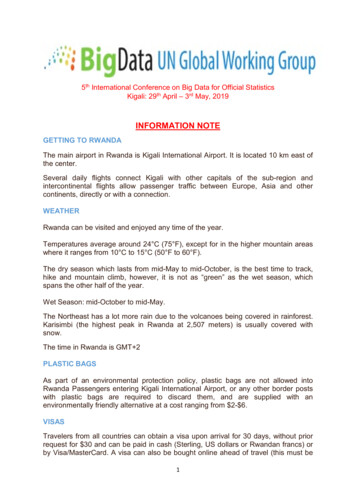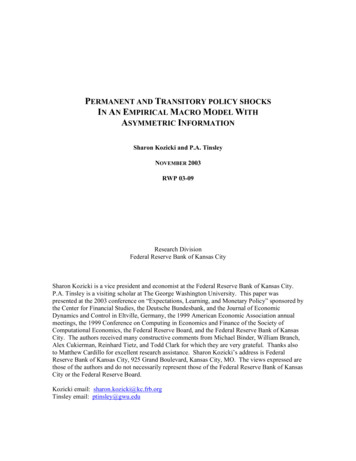
Transcription
F E D E R A L R E S E R V E B A N K O F S T. LO U I SOffice of Minority andWomen Inclusion2015 ANNUAL REPORT TO CONGRESS
Table of ContentsMessage from the President. . . . . . . . . . . . . . . . . . . . . . . . . . . . . . . . . . . . 3Executive Summary. . . . . . . . . . . . . . . . . . . . . . . . . . . . . . . . . . . . . . . . . . . . . . . 4Overview. . . . . . . . . . . . . . . . . . . . . . . . . . . . . . . . . . . . . . . . . . . . . . . . . . . . . . . . . . . . . . 6Employment. . . . . . . . . . . . . . . . . . . . . . . . . . . . . . . . . . . . . . . . . . . . . . . . . . . . . . . . . 7Procurement. . . . . . . . . . . . . . . . . . . . . . . . . . . . . . . . . . . . . . . . . . . . . . . . . . . . . . . 10Financial Literacy. . . . . . . . . . . . . . . . . . . . . . . . . . . . . . . . . . . . . . . . . . . . . . . . . . 12Conclusion. . . . . . . . . . . . . . . . . . . . . . . . . . . . . . . . . . . . . . . . . . . . . . . . . . . . . . . . . . . 14Appendices. . . . . . . . . . . . . . . . . . . . . . . . . . . . . . . . . . . . . . . . . . . . . . . . . . . . . . . . . 158HTHE EIGHTH FEDERAL RESERVE DISTRICTARKANSAS ILLINOIS INDIANA KENTUCKY MISSISSIPPI MISSOURI TENNESSEE
Message from the PresidentJames BullardPresident and CEOEnclosed is the 2015 Office of Minority and Women Inclusion (OMWI) Congressional Reportfrom the Federal Reserve Bank of St. Louis.This report outlines many of the diversity and inclusion activities undertaken by the Bank in2015. We implemented these actions not only to comply with Section 342 of the Dodd-FrankWall Street Reform and Consumer Protection Act of 2010, but also to enhance the effectiveness and strength of our organization. The report also describes some of the successes andchallenges that we encountered during 2015.At the Federal Reserve Bank of St. Louis, we continue to believe that we better serve theAmerican public by building a more diverse and inclusive organization. Our commitmentto diversity and inclusion, at all levels of the organization, remains strong as we collectivelywork to enhance our OMWI efforts.3
Executive SummaryThe mission of the Federal Reserve Bank of St. Louisis to promote stable prices, encourage maximumsustainable economic growth and support financialstability for constituents in our District and throughout theUnited States, by: advancing monetary policy focused on low inflation; performing effectively as the fiscal agent and depository of the U.S. Treasury; fostering safe and responsible banking practices; providing beneficial regional economic research, community development programs, and economic andfinancial education; and providing and promoting efficient, reliable and accessible payments services.The core values that guide the St. Louis Fed’s organizationaldecisions and employees’ actions are: Commitment to the Public Interest: We provide costeffective, value-added goods and services to the public,U.S. government and the financial community consistentwith our mission and mindful of our legacy. Constituent Focus: We use input from our constituentsto understand their needs, and we design, enhance anddeliver high-quality goods and services in response. Diversity and Inclusion: We value the diversity of oneanother and the benefits derived from collaboration,teamwork and open communications. Independence of Views: We value professional judgment and seek input from a variety of sources to improve decision-making. Innovation: We promote and support the pursuit ofcreative ideas for improvement. Integrity and Respect: We operate in a transparentmanner and adhere to the highest standards of honesty,fairness and discretion in our dealings with the public,business partners and our colleagues. Ownership: We value personal ownership and accountability as a key to fostering high levels of performance.Established by the Dodd-Frank Wall Street Reform andConsumer Protection Act of 2010, the Federal ReserveBank of St. Louis’ Office of Minority and Women Inclusion(OMWI) is responsible for developing standards and procedures to ensure the inclusion of minorities, women, andminority-owned and women-owned business enterprises(MWBE) in all activities of the Bank, including procurementand workforce diversity. The St. Louis Fed’s diversity programpredates the passage of the Dodd-Frank Act and remainsfocused on driving and developing strategies to enhancethe culture of diversity and inclusion within the organization. In support of the Bank’s core values, the OMWI is a keycomponent of that culture.Similar to the Offices of Minority and Women Inclusion atthe 11 other regional Federal Reserve banks and the FederalReserve’s Board of Governors, the OMWI at the St. LouisFed is responsible for matters relating to diversity and inclusion. Under the guidance and direction of St. Louis FedPresident and Chief Executive Officer James Bullard andVice President of Diversity and OMWI Director Kathy Freeman, the OMWI works to ensure that employment, supplierand outreach opportunities are available to broadly diversepopulations and that our staff and vendors reflect the environment in which we do business. The OMWI has dedicatedstaff of three full-time employees, along with resources intalent acquisition, procurement and economic education.The St. Louis Fed is committed to improving workforce diversity at all levels because having a diverse staff strengthens both the St. Louis Fed and the communities we serve.We continued to strengthen our workforce diversity outreach, focusing efforts on the recruitment program as wellas enhancing onboarding and professional developmentofferings. As in the past, the Bank continued to attend andsupport national diversity recruiting fairs, provide collegeinternship opportunities, enhance its onboarding programInternships Offer InsightsSt. Louis Fed interns concluded their programwith a capstone project designed to createinterdisciplinary project teams to work on realbusiness challenges. Interns made formal presentations to management regarding their recommendations, which provided them a venueto showcase their skills in teamwork, problemsolving and time management. Six of our 2015interns either transitioned to St. Louis Fedemployees in 2015 or will transition to aBank employee in 2016 upon graduation.4
for new employees and new leaders, and encourage participation in employee-led groups like employee resourcegroups (ERG) and the Diversity and Inclusion Council. Partnerships with diverse community organizations that serveminorities and women continue to provide avenues throughwhich we attract top talent to the organization.The St. Louis Fed seeks to do business with a wide, diverserange of responsible suppliers for a variety of goods andservices. We encourage the participation of MWBE’s tocompete for procurement contracts. The Supplier Diversity Program continues to grow and mature. The Bank hasmade consistent progress to enhance the ability of MWBEvendors to provide the Bank with goods and services. In thelast five years the MWBE spend increased from 7.1 percentin 2011 to 24.7 percent in 2015. (See chart on page 11.) TheSupplier Diversity Program, in collaboration with the Bank’sprocurement professionals, partners with the OMWI to promote, monitor and report the District’s activity in diversifying the supplier base. Procurement efforts have centeredon expanding the vendor pools and contractor pipelines,enhancing the Bank’s outreach via hosting and attendingnetworking events that offer one-on-one vendor matchingand technical assistance, and enhancing internal and external communications to raise awareness about the Bank’scommitment to supplier diversity.For decades, the St. Louis Fed has been actively involved indeveloping and delivering economic education and financialliteracy programs to schools and educators throughout theEighth District and nationwide. Because financial literacyempowers consumers to make choices that will contributeto their well-being, we make a positive impact on innercity, girls’ and majority-minority schools. In 2015, the Bankinteracted with 100 percent of the 240 OMWI-defined highschools within the Eighth District.The St. Louis Fed conducted its biennial Bank-wide employee engagement survey in 2015 to assess a broad set ofdata on, among other things, diversity and inclusion. Witha diversity and inclusion score of 4.17 on a 5-point scale, theBank improved on its 2013 score of 4.10. The results reflectour organization’s commitment to incorporate diversity andleverage inclusion into our workplace values and to fostera culture of inclusion in thought, perspective and employeedemographics.This annual report, as stipulated by Section 342 of theDodd-Frank Act, details specific work and progress madeduring the reporting period. Assessment of inclusion programs in regulated entities is the responsibility of the Boardof Governors of the Federal Reserve System and thereforeis not addressed in this report.The Bank continued its strong community outreachefforts with several events and conferences includingDiálogo con la Fed, which was held at the MemphisBranch. Diálogo con la Fed is the Bank’s Spanish-language edition of itsDialogue with theFed discussion seriesfor the general publicin which Fed officialsaddress key economic and financialissues and answerquestions from theaudience.Reaching Out through Education More than 709,000 enrollments were attained in 2015 through theSt. Louis Fed’s Econ Lowdown program, which is used in schools in all 50states and in several countries. Helping kids understand and apply concepts such as saving, spending, budgeting, decision-making, opportunitycost and more, from early childhood through the teenage years, is an important component of the Bank’s role in economic and financial education.The Econ Lowdown program includes online courses such as “It’s YourPaycheck,” “Cars, Cards and Currency” and “Credit Cred,” which help highschool students learn and apply personal finance concepts as they starttheir first job and earn a paycheck, make decisions such as buying a car,and apply for and build strong credit.5
OverviewBackgroundGeography CoveredThe Federal Reserve Bank of St. Louis is one of 12 regionalReserve banks in the United States that, together withthe Board of Governors in Washington, D.C., make up theFederal Reserve System—the nation’s central bank. Sinceits establishment by an act of Congress in 1913, the FederalReserve System’s primary goal has been to foster a soundfinancial system and a healthy economy. To advance thisgoal, the St. Louis Fed and the other regional Reserve bankshelp formulate monetary policy, supervise and regulatebanks and bank holding companies, and provide financialservices to depository institutions and the federal government. Each Federal Reserve Bank is separately incorporated, and each has a president and a board of nine directors.The Federal Reserve Bank of St. Louis territory coversthe Eighth Federal Reserve District, which includes allof Arkansas, eastern Missouri, southern Illinois, southernIndiana, western Kentucky, western Tennessee and northernMississippi. Branch offices are located in Little Rock,Louisville and Memphis.In accordance with Section 342 of the Dodd-Frank Wall StreetReform and Consumer Protection Act of 2010, each ReserveBank, along with the Board, established an Office of Minorityand Women Inclusion (OMWI) that is responsible for all matters relating to diversity in management, employment andbusiness activities. The St. Louis Fed established its office inNovember 2010. Kathy Freeman, vice president and OMWIdirector, reports directly to the Bank’s president and has a staffof two full-time employees. A team of strategic advisers, business partners and the St. Louis Fed’s Diversity Advisory Groupalso support the St. Louis OMWI to bring diverse business,geographic and staff perspectives that influence the Bank’sdiversity and inclusion direction and decisions. The Bank’scommitment to diversity and inclusion is reflected at all levelsof the organization.Unique District Activities and SystemResponsibilitiesThe Bank is an international leader in providing onlineeconomic and financial information. The Bank’s Federal Reserve Economic Data, or FRED , is a database of more than383,000 economic time series from 82 national, international, public and private sources. FRED, created and maintained by the Bank’s Research division, goes far beyondsimply providing data. It combines data with a powerful mixof tools that help the user understand, interact with, displayand disseminate the data. In essence, FRED helps users telltheir data stories.The Bank’s Treasury Relations and Support Office (TRSO)coordinates and manages the relationship between the Department of the Treasury and the Federal Reserve System,serving as the central point of contact for policy issues,new initiatives and problem resolution. The TRSO assiststhe Treasury with identifying and pursuing strategic initiatives benefiting both the Treasury and the Federal ReserveSystem, while supporting the successful completion of allTreasury-related Fed System initiatives.Regional GeographyThe Eighth District covers a portion of the Midwest and Midsouth regions. The Bank has offices in St. Louis (headquarters);Memphis, Tenn.; Louisville, Ky.; and Little Rock, Ark. The Memphis Branch duties include cash processing, supervision andregulation of financial institutions, and community development activities. The duties at the Little Rock and Louisvillebranches include supervision and regulation of financial institutions, and community development activities. All offices provide economic education outreach programs to the communities they serve. The outreach activities and programs at eachbranch are led by a regional executive.ILLINOISINDIANASt. LouisMISSOURILouisvilleKENTUCKYTENNESSEELittle Rock6Nikki R. JacksonRegional ExecutiveLouisville BranchDouglas ScarboroRegional ExecutiveMemphis BranchARKANSASMISSISSIPPIRobert A. HopkinsRegional ExecutiveLittle Rock BranchMemphis
Employment of Minorities and WomenThe Bank is committed to building a work environmentas diverse as the public it serves. During 2015, theBank continued its efforts to attract and recruit potential employees from a diverse candidate pool while developing and retaining its best employees. In support of thiscommitment, the Bank’s policies and procedures are designed to provide opportunities for minorities and womenat all levels. In addition, building a diverse leadership pipeline is a critical component of the Bank’s OMWI strategy.SuccessesIn 2015, the St. Louis Fed experienced success in the following key areas with regard to workforce diversity initiatives.Recruitment and Retention of a Diverse WorkforceIn 2015, the St. Louis Fed’s staff (Appendix B) reflected adiverse employee population when compared to relevantjob groups (professionals, mid-level managers, senior executives) in the St. Louis Metropolitan Statistical Area (MSA).Broadly speaking, the St. Louis Fed workforce is 26 percentminority and 43 percent women. A comparison of theBank’s workforce in the top three job groups—84 percentof the workforce—to aggregate representation in these jobgroups revealed that the overall representation of women issimilar to MSA levels and that minorities exceed MSA levels(as reported in the 2010 U.S. Census EEO data for the MSA).Of the 200 employees hired externally by the Bank in 2015,minorities accounted for 37 percent and women 40 percent.Of the 19 employees promoted within the official ranks, minorities accounted for 21 percent and women 42 percent.Enhanced Diversity Recruiting StrategyThe St. Louis Fed implemented a comprehensive diversityand inclusion recruiting strategy in support of building aninclusive workplace, where our differences—in gender, race,age and ethnicity, as well as in cultural traditions, religion,life experiences, education, sexual orientation and socioeconomic backgrounds—are recognized as our strength.The diversity recruiting strategy focuses on continuing tobuild strategic relationships through internal and externalavenues, positioning the Bank to have an available networkof candidates, in addition to growing talent within the organization. In addition, the St. Louis Fed pursues tactics thathelp define and minimize unconscious bias. Tactics include:empowering recruiters through training and education; pursuing opportunities for the Eighth District to be recognizedas a diverse employer of choice; measuring the success ofthe diversity recruiting efforts; and planning for the futurethrough strategic workforce planning and organizationaldevelopment.In support of the diversity recruiting strategy, candidate poolsare monitored for the inclusion of women and minorities. Inorder to decrease unconscious bias, candidate identifiers suchas name and address are removed from resumes before presentation to a hiring manager. In 2015, all of the Bank’s recruiters received the AIRS Certified Diversity Recruiter designation.AIRS classes introduce participants to a host of free sourcingtools and techniques with the goal of boosting recruiter effectiveness. Through this certification, recruiters gain the information, tools, resources and strategies to help them create orimprove upon diversity recruiting efforts.Positions with a direct line to leadership responsibilitiesare generally posted internally and externally to generate abroad pool of candidates, a process originally implementedin 2012. Final candidates are interviewed by a panel ofBank employees who have been trained on the behavioralinterviewing process. This allows for a more consistentinterviewing experience for the candidates and a broadermindset of the individuals making recommendations on theideal candidate. Additionally, the panelists are selected byboth the hiring manager and Human Resources to ensurethe panel is diverse and well-rounded.Fairs, Promotions and PartnershipsThe Bank participated in national and regional job fairssponsored in urban communities and/or geared towardminorities and women. In March of 2015, the Bank hostedan IT career fair for approximately 300 individuals to network and learn about current and upcoming opportunities,as well as to experience our culture. To encourage minorityattendance at the fair, the Bank placed an ad in the St. LouisAmerican, which is a weekly newspaper serving the AfricanAmerican community of St. Louis.In addition, the Bank updated its print media and careerwebsite to ensure representation of minorities and womenand to promote key elements of the Bank’s diverse andinclusive culture.In 2015, the Bank continued to partner with organizationssuch as INROADS, the Hispanic Chamber of Commerce(HCC), Urban Financial Services Coalition (UFSC) andNational Black MBA Association (NBMBAA).Relationship Building with Eighth District HBCUsThe Bank continues to build upon relationships with Historically Black Colleges and Universities (HBCUs), having madecampus visits to Kentucky State University, Philander SmithCollege, Lincoln University, Harris-Stowe State University(HSSU), the University of Arkansas Pine-Bluff (UAPB) andMississippi Valley State University.7
Strategic alignment continued with five HBCUs in theDistrict. These included a face-to-face meeting with thepresident, faculty and administration of Lincoln University,and engagement with representatives of HSSU, includingfacilitating a session on professional development. TheBank hosted an on-site visit for 22 students and four faculty from UAPB. During their visit, students participated inseveral events, including “Mentor for a Day” and a variety ofnetworking opportunities. This visit led to opportunities foradditional outreach, and five UAPB students secured internships during the summer of 2015.Additionally, 11 students and administrators from UAPB,eight from HSSU and 10 from Lincoln University attendedthe fourth annual Day at the Fed in October. This event forcollege students and professors within the Eighth Districtwas attended by approximately 150 students and 20 professors. It is designed to educate college students aboutcareer opportunities at the Bank, with an emphasis on careers as bank examiners.College Internship ProgramThe St. Louis Fed hosted a total of 33 summer interns in 2015(11 women and 16 minorities). Ten of these students attendedan HBCU, and three were from INROADS. Six of our 2015 interns either transitioned to St. Louis Fed employees in 2015 orwill transition to a Bank employee in 2016 upon graduation. Ofthose six full-time hires, two were minorities, two were HBCUgraduates, and one was a women.The program provides interns with challenging work anddevelopmental opportunities. The interns participated inworkshops that help build their competencies and preparethem for a corporate setting. They also had the opportunityto work with management and senior leaders. The desiredoutcome was to provide the students with career skills andopportunities to return to the Bank as an intern or a fulltime employee.Training and DevelopmentThe Bank continued its commitment to providing diversity and inclusion workshops to all new employees. Newmanagers participated in a full-day diversity leadershipworkshop. Employees new to the Bank participated in ahalf-day workshop that focused on improving employeeunderstanding of diversity and inclusion.All staff from Human Resources and Diversity and Inclusion participated in three all-day Diversity and InclusionChange Agent Development Journey workshops facilitatedby an external vendor. The sessions helped team membersdevelop competencies as change agents in diversity andinclusion.The St. Louis Fed supported employees in establishingemployee resource groups (ERG). An ERG is a voluntary,employee-led group approved by the Bank, open to employees, and formed around common interests includingparticular characteristics. To date, the Bank has four ERGs,in which about 10 percent of employees are members.8The Bank structured the ERGs in a way that provides leadership opportunities and exposure to involved staff andmanagement. All four current ERGs are chaired by womenand/or minorities. Each ERG has a senior leader as its executive sponsor. The executive sponsor’s role includes coaching, mentoring, becoming knowledgeable about concernsaffecting the group, acting as an advocate, and sharinginformation with other Bank leaders.The ERGs, which are open to all employees regardless ofdemographic, are listed below. Each ERG seeks to helpthe Bank become a preferred employer recognized for aworking environment where employees can learn, growand succeed.African-American Council of Talented, Innovative,Visionary Employees (AACTIVE)The AACTIVE ERG exists to support the Bank’s AfricanAmerican Community.AsianThe Asian ERG exists to support the Bank’s Asian community. Asian refers to individuals from or who have culturalties to the continent of Asia and the Indo-Pacific islands.Lesbian, Gay, Bisexual, Transgender and AlliesPartnership (LGBTA)The LGBTA Partnership ERG exists to support the enrichmentof the diverse and inclusive culture of the St. Louis Fed.Valuing, Inspiring, Empowering Women (VIEW)The VIEW ERG exists to support the women who work atthe St. Louis Fed.The St. Louis Fed’s Diversity and Inclusion Council promotesemployee awareness about the value of diversity and inclusion, and sponsors diversity and inclusion efforts that engage employees across the Bank and align with the Bank’score business strategies. Council members plan, lead andcoordinate panels and presentations by internal and external speakers, as well as cultural and educational events thatcelebrate diversity and inclusion. Collaboration among thecouncil and ERGs resulted in more than 20 events during2015. Highlights include: cultural observances, panels andpresentations, networking events and educational sessions.To enhance and support diversity and inclusion competencies, the Diversity and Inclusion Council and ERGs participated in an all-day summit facilitated by an external vendor.The summit focused on factors critical to the success of thegroups, as well as strategic planning for 2016. In addition, awell-attended session dedicated to all Bank leaders focusedon the value of the council and ERGs to the Bank.MentoringThe St. Louis Fed’s Mentoring Program pairs two employees(a mentor and a mentee) to share knowledge and experiences, creating a valuable and unique development opportunity. Mentors broaden their leadership skills by sharingtheir experiences, offering professional development adviceor just by serving as a sounding board for their mentees.
Mentees emerge from the experience with a broader perspective of the Bank’s environment and information thatmay help them make better decisions in their jobs. Thementoring program is open to all employees, regardless oftenure, to allow employees access to a diverse pool of experienced mentors. In 2015, 26 mentors and mentees werepaired, with two minority and 16 women mentors and fiveminority and 19 women mentees. New Manager Development Program Attracting top candidates from national recruiting conferences aimed at women and minorities is particularlychallenging when the applicant has no personal ties tocities in the Eighth District. There is a perception among some minority applicantsthat the Bank’s lack of minorities at the executive levelsuggests an inability to rise up through the ranks. Specialized and leadership positions have significantcompetition for minority talent within the Eighth District. While still a challenge, results are trending upward.There is still some pressure for female talent in the technology space, as well, due to market demand.The New Manager Program was introduced to foster support for all new managers to ensure skill development,engagement and retention. The program is a comprehensive, 24-month program, designed to help new managersunderstand Bank technology, processes and culture, as wellas to develop skills based on manager-level competencies.As part of the program, all managers are expected to participate in a series of required and elective courses, experiences and sessions. More specific Bank culture activities arealso included to help broaden participants’ understandingof the business and people of the Eighth District.There are currently 46 managers in the program:27 are women, and 12 are minorities.Federal Reserve System InitiativesThe St. Louis Fed participated in the System LeadershipInitiative (SLI). The SLI is a development program for theFederal Reserve System’s key talent. In 2015, two conferences were offered at the emerging and senior executiveleadership tiers. Notably, sessions on bias, particularlyunconscious bias, were presented by an industry expert atboth conferences. The SLI team has worked to evolve thecontent and worked with all speakers to address broadercollaboration, engaging different perspectives and gettingthe most from leading diverse teams. As the leadershipconferences reach a broad pipeline of talent across theSystem, the System’s OMWI directors and SLI continued tocollaborate to expand the content and discussion of diversity and inclusion in these conferences.Minority and female participation is tracked and reportedto ensure that development opportunities are reaching adiverse pool of leaders. Diversity of participants will continue to be an area of emphasis by encouraging traditionaland nontraditional candidates to participate, and reportingprogress on a regular basis to System Human Resourcesand OMWI leaders.Broadly promoting a wide variety of Diversity and Inclusion Council and ERG programming to enhance awareness, promote inclusive behaviors and support professional development.ChallengesMany of the challenges listed in the 2014 OMWI Congressional Report remain. These include:Next StepsIn an effort to continue making progress in the employmentof minorities and women, the St. Louis Fed will continue: Enhancing and executing the Bank’s diversity recruitingstrategy to ensure that the applicant pool is well represented by women and minorities. Partnering with technical and professional organizationsthat focus on women and minorities as members. Refining and expanding the College Internship Program. Utilizing diverse marketing outlets to advertise employment opportunities. Enhancing and executing the Bank’s College OutreachStrategy to foster deeper engagement with HBCUsin the Eighth District. Educating hiring managers on their role in supportingdiversity recruiting efforts. Focusing on strategic workforce planning acrossthe organization.CommunicationsOMWI enhanced its communications in 2015 by: Completing an annual workforce utilization analysis andaction plan for women and minorities and reviewing theresults with senior management and the St. Louis Fed’sBoard of Directors. Regularly reporting to the St. Louis Fed’s executive office and senior management on the status of diversityand inclusion initiatives, actions and outcomes.9
Procurement: Inclusion of Minority andWomen Business EnterprisesTProvide access and opportunity to a diverse pool ofsuppliers that include minority- and women-ownedbusinessesThis focus requires not only applying comprehensive sourcing efforts across a number of resources and directories,but also proactively creating and fostering productive relationships with new and existing suppliers. To cultivate theserelationships, the Bank participates in various advocacygroups and chambers of commerce to identify supplierswhose expertise matches the St. Louis Fed’s procurementneeds. Additional support has been provided by the National Procurement Office (NPO), based at the Federal ReserveBank of Richmond, which is responsible for managing andfacilitating contracts that may be used by any of the Federal Reserve banks.DIVERSE VENDOR CONTRACTING AWARDS ANDOPPORTUNITIES IN 2015he St. Louis Fed’s OMWI continues to support andinflue
empowers consumers to make choices that will contribute to their well-being, we make a positive impact on inner-city, girls' and majority-minority schools. In 2015, the Bank interacted with 100 percent of the 240 OMWI-defined high schools within the Eighth District. The St. Louis Fed conducted its biennial Bank-wide em-




